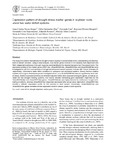Por favor, use este identificador para citar o enlazar este ítem:
http://www.alice.cnptia.embrapa.br/alice/handle/doc/926588Registro completo de metadatos
| Campo DC | Valor | Lengua/Idioma |
|---|---|---|
| dc.contributor.author | NEVES-BORGES, A. C. | pt_BR |
| dc.contributor.author | GUIMARÃES-DIAS, F. | pt_BR |
| dc.contributor.author | CRUZ, F. | pt_BR |
| dc.contributor.author | MESQUITA, R. O. | pt_BR |
| dc.contributor.author | NEPOMUCENO, A. L. | pt_BR |
| dc.contributor.author | ROMANO, E. | pt_BR |
| dc.contributor.author | LOUREIRO, M. E. | pt_BR |
| dc.contributor.author | GROSSI-DE-SÁ, M. de F. | pt_BR |
| dc.contributor.author | ALVES-FERREIRA, M. | pt_BR |
| dc.date.accessioned | 2012-06-18T11:11:11Z | pt_BR |
| dc.date.available | 2012-06-18T11:11:11Z | pt_BR |
| dc.date.created | 2012-06-18 | pt_BR |
| dc.date.issued | 2012 | pt_BR |
| dc.identifier.citation | Genetics and Molecular Biology, Ribeirão Preto, v. 35, n. 1, suppl., p. 212-221, May 2012. | pt_BR |
| dc.identifier.uri | http://www.alice.cnptia.embrapa.br/alice/handle/doc/926588 | pt_BR |
| dc.description | The study of tolerance mechanisms for drought stress in soybean is fundamental to the understanding and development of tolerant varieties. Using in silico analysis, four marker genes involved in the classical ABA-dependent and ABA-independent pathways of drought response were identified in the Glycine max genome in the present work. The expression profiles of the marker genes ERD1-like, GmaxRD20A-like, GmaxRD22-like and GmaxRD29B-like were investigated by qPCR in root samples of drought sensitive and tolerant soybean cultivars (BR 16 and Embrapa 48, respectively), submitted to water deficit conditions in hydroponic and pot-based systems. Among the four putative soybean homologs to Arabidopsis genes investigated herein, onlyGmaxRD29B-like was not regulated by water deficit stress. Distinct expression profiles and different induction levels were observed among the genes, as well as between the two drought-inducing systems. Our results showed contrasting gene expression responses for the GmaxRD20A-like and GmaxRD22-like genes. GmaxRD20A-like was highly induced by continuous drought acclimating conditions, whereas GmaxRD22-like responses decreased after abrupt water deprivation. GmaxERD1-like showed a different expression profile for the cultivars in each system. Conversely, GmaxRD20A-like and GmaxRD22-like genes exhibited similar expression levels in tolerant plants in both systems. | pt_BR |
| dc.language.iso | eng | eng |
| dc.rights | openAccess | eng |
| dc.subject | Estresse hídrico | pt_BR |
| dc.subject | Marker genes | pt_BR |
| dc.subject | Drougth adaptation | pt_BR |
| dc.title | Expression pattern of drought stress marker genes in soybean roots under two water deficit systems. | pt_BR |
| dc.type | Artigo de periódico | pt_BR |
| dc.date.updated | 2012-07-17T11:11:11Z | pt_BR |
| dc.subject.thesagro | Soja | pt_BR |
| dc.subject.thesagro | Deficiência hídrica | pt_BR |
| dc.subject.thesagro | Resistência a seca | pt_BR |
| dc.subject.thesagro | Marcador genético | pt_BR |
| dc.subject.thesagro | Gene | pt_BR |
| dc.subject.thesagro | Genoma | pt_BR |
| dc.subject.nalthesaurus | Soybeans | pt_BR |
| dc.subject.nalthesaurus | Plant-water relations | pt_BR |
| dc.subject.nalthesaurus | Drought tolerance | pt_BR |
| dc.subject.nalthesaurus | Genes | pt_BR |
| dc.subject.nalthesaurus | Genome | pt_BR |
| riaa.ainfo.id | 926588 | pt_BR |
| riaa.ainfo.lastupdate | 2012-07-17 | pt_BR |
| dc.contributor.institution | ANNA CRISTINA NEVES BORGES, UFRJ; FÁBIA GUIMARÃES DIAS, UNIRIO; FERNANDA CRUZ, UNIRIO; ROSILENE OLIVEIRA MESQUITA, UFV; ALEXANDRE LIMA NEPOMUCENO, SRI; EDUARDO ROMANO DE CAMPOS PINTO, CENARGEN; MARCELO EHLERS LOUREIRO, UFV; MARIA FATIMA GROSSI DE SA, CENARGEN; MÁRCIO ALVES-FERREIRA, UNIRIO. | pt_BR |
| Aparece en las colecciones: | Artigo em periódico indexado (CNPSO)  | |
Ficheros en este ítem:
| Fichero | Descripción | Tamaño | Formato | |
|---|---|---|---|---|
| gmb.expression.v35n1s.212221.2012.pdf | 2,04 MB | Adobe PDF |  Visualizar/Abrir |









